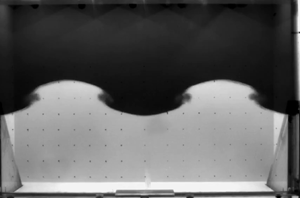Article contents
The subcritical transition to turbulence of Faraday waves in miscible fluids
Published online by Cambridge University Press: 19 January 2022
Abstract

We study the development and the breaking process of standing waves at the interface between two miscible fluids of small density contrast. In our experiment, a subharmonic wave is generated by a time-periodic vertical acceleration via the Faraday instability. It is shown that its wavelength may be selected not only by the linear process predicted by the Floquet theory and favouring the most unstable modes allowed by the tank geometry, but also by a nonlinear mode competition mechanism giving the preference to subcritical modes. Subsequently, as the standing wave amplitude grows, a secondary destabilization process occurs at smaller scales and produces turbulent mixing at the nodes. We explain this phenomenon as a subcritical parametric resonance instability. Different approaches derived from local and global stability analysis are proposed to predict the critical wave steepness. These theories are then assessed against various numerical and experimental data varying the frequencies and amplitudes of the forcing acceleration.
Information
- Type
- JFM Papers
- Information
- Copyright
- © The Author(s), 2022. Published by Cambridge University Press
References
REFERENCES
Cavelier et al. supplementary movie 3
Movie of a vertical slice of the concentration eld extracted from simulation DNSa2 (see parameters in table 2).
Cavelier et al. supplementary movie 4
Movie of a vertical slice of the concentration eld extracted from simulation DNSa3 (see parameters in table 2).
- 8
- Cited by

